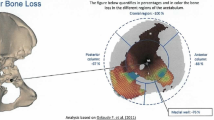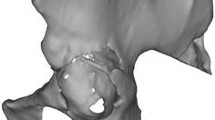Abstract
Background
Press-fit acetabular component seating in hip resurfacing can be challenging as a strong interference fit is required. It has not been established whether reducing the acetabular underream minimizes incomplete component seating or leads to increased acetabular loosening.
Questions/purposes
We examined (1) the incidence and natural history of postoperative interference gaps in hip resurfacing and (2) whether reduction of the acetabular underream from 2 mm to 1 mm reduces the incidence of periacetabular interference gaps.
Methods
Of 327 Birmingham Hip™ Resurfacings (Smith & Nephew Inc, Memphis, TN, USA) performed by a single surgeon from 2005 to 2010, we evaluated 306 hips with a minimum 1-year radiographic followup. Postoperative periacetabular interference gaps were monitored for radiographic gap resolution at latest followup. The frequency of incomplete component seating was compared between acetabula prepared with 1- and 2-mm underream techniques. Minimum followup was 1 year (mean, 2.7 years; range, 1–6 years).
Results
Fifty-one percent of the postoperative radiographs demonstrated the presence of a periacetabular interference gap. At latest followup, 96% of these gaps were no longer visible. We observed a reduction in the number of interference gaps identified when acetabular preparation changed from a 2-mm underream (63%) to a 1-mm underream (39%). There were no revisions due to acetabular failure.
Conclusions
Periacetabular interference gaps were common in this series but not associated with acetabular component failure. The use of a 1-mm underream is sufficient for adequate short-term press-fit fixation of the acetabular component in Birmingham Hip™ Resurfacing arthroplasty.
Level of Evidence
Level IV, therapeutic study. See Instructions for Authors for a complete description of levels of evidence.



Similar content being viewed by others
References
Adler E, Stuchin SA, Kummer FJ. Stability of press-fit acetabular cups. J Arthroplasty. 1992;7:295–301.
Amstutz HC, Takamura KM, Le Duff MJ. The effect of patient selection and surgical technique on the results of Conserve® Plus hip resurfacing—3.5- to 14-year follow-up. Orthop Clin North Am. 2011;42:133–142, vii.
Curtis MJ, Jinnah RH, Wilson VD, Hungerford DS. The initial stability of uncemented acetabular components. J Bone Joint Surg Br. 1992;74:372–376.
DeLee JG, Charnley J. Radiological demarcation of cemented sockets in total hip replacement. Clin Orthop Relat Res. 1976;121:20–32.
Dorr LD, Wan Z, Cohen J. Hemispheric titanium porous coated acetabular component without screw fixation. Clin Orthop Relat Res. 1998;351:158–168.
Gruen TA, Poggie RA, Lewallen DG, Hanssen AD, Lewis RJ, O’Keefe TJ, Stulberg SD, Sutherland CJ. Radiographic evaluation of a monoblock acetabular component: a multicenter study with 2- to 5-year results. J Arthroplasty. 2005;20:369–378.
Hulst JB, Ball ST, Wu G, Le Duff MJ, Woon RP, Amstutz HC. Survivorship of Conserve® Plus monoblock metal-on-metal hip resurfacing sockets: radiographic midterm results of 580 patients. Orthop Clin North Am. 2011;42:153–159, vii.
Kaneko K, Inoue Y, Yanagihara Y, Uta S, Mogami A, Iwase H. The initial fixation of the press-fit acetabular shell—clinical observation and experimental study. Arch Orthop Trauma Surg. 2000;120:323–325.
Khan M, Kuiper JH, Edwards D, Robinson E, Richardson JB. Birmingham Hip Arthroplasty: five to eight years of prospective multicenter results. J Arthroplasty. 2009;24:1044–1050.
Kim YS, Callaghan JJ, Ahn PB, Brown TD. Fracture of the acetabulum during insertion of an oversized hemispherical component. J Bone Joint Surg Am. 1995;77:111–117.
Macheras GA, Papagelopoulos PJ, Kateros K, Kostakos AT, Baltas D, Karachalios TS. Radiological evaluation of the metal-bone interface of a porous tantalum monoblock acetabular component. J Bone Joint Surg Br. 2006;88:304–309.
MacKenzie JR, Callaghan JJ, Pedersen DR, Brown TD. Areas of contact and extent of gaps with implantation of oversized acetabular components in total hip arthroplasty. Clin Orthop Relat Res. 1994;298:127–136.
Merican AM, Randle R. Early clinical and radiographic analysis of the Fitmore cup. J Arthroplasty. 2006;21:846–851.
Moore MS, McAuley JP, Young AM, Engh CA. Radiographic signs of osteointegration in porous-coated acetabular components. Clin Orthop Relat Res. 2006;444:176–183.
Morscher E, Berli B, Jockers W, Schenk R. Rationale of a flexible press fit cup in total hip replacement: 5-year followup in 280 procedures. Clin Orthop Relat Res. 1997;341:42–50.
Morscher E, Masar Z. Development and first experience with an uncemented press-fit cup. Clin Orthop Relat Res. 1988;232:96–103.
Ng FY, Zhu Y, Chiu KY. Cementless acetabular component inserted without screws—the effect of immediate weight-bearing. Int Orthop. 2007;31:293–296.
Onsten I, Carlsson AS, Sanzen L, Besjakov J. Migration and wear of hydroxyapatite-coated hip prosthesis: a controlled roentgen stereophotogrammetric study. J Bone Joint Surg Br. 1996;78:85–91.
Rahman L, Muirhead-Allwood SK, Alkinj M. What is the midterm survivorship and function after hip resurfacing? Clin Orthop Relat Res. 2010;468:3221–3227.
Randolph JJ. Online kappa calculator. 2008. Available at: http://justus.randolph.name/kappa. Accessed March 31, 2012.
Smith & Nephew Inc. Surgical technique: Birmingham Hip™ Resurfacing system. Available at: http://global.smith-nephew.com/cps/rde/xbcr/smithnephewls/ BHR_ST_Low_Res.pdf. Accessed March 21, 2012.
Springer BD, Griffin WL, Fehring TK, Suarez J, Odum S, Thompson C. Incomplete seating of press-fit porous-coated acetabular components: the fate of zone 2 lucencies. J Arthroplasty. 2008;23(6 suppl 1):121–126.
Steffen RT, Pandit HP, Palan J, Beard DJ, Gundle R, McLardy-Smith P, Murray DW, Gill HS. The five-year results of the Birmingham Hip Resurfacing arthroplasty: an independent series. J Bone Joint Surg Br. 2008;90:436–441.
Stiehl JB, MacMillan E, Skrade DA. Mechanical stability of porous-coated acetabular components in total hip arthroplasty. J Arthroplasty. 1991;6:295–300.
Torga Spak R, Stuchin SA. Cementless porous coated sockets without holes implanted with pure press-fit technique: average 6 year follow-up. J Arthroplasty. 2005;20:4–10.
Udomkiat P, Dorr LD, Wan Z. Cementless hemispheric porous-coated sockets implanted with press-fit technique without screws: average ten-year follow-up. J Bone Joint Surg Am. 2002;84:1195–1200.
Acknowledgments
The authors would like to thank Zachary Morison, MSc, for the preparation of the imaging used by the observers in the study and tabulation of the data.
Author information
Authors and Affiliations
Corresponding author
Additional information
One or more of the authors (EHS) has received or may receive payments or benefits, in any 1 year, an amount in excess of $10,000 from a commercial entity (Smith & Nephew Inc, Memphis, TN, USA) related to this work.
All ICMJE Conflict of Interest Forms for authors and Clinical Orthopaedics and Related Research editors and board members are on file with the publication and can be viewed on request.
Clinical Orthopaedics and Related Research neither advocates nor endorses the use of any treatment, drug, or device. Readers are encouraged to always seek additional information, including FDA approval status, of any drug or device before clinical use.
Each author certifies that his or her institution approved the human protocol for this investigation, that all investigations were conducted in conformity with ethical principles of research, and that informed consent for participation in the study was obtained.
About this article
Cite this article
Gomes, B., Olsen, M., Donnelly, M. et al. Should We Worry About Periacetabular Interference Gaps in Hip Resurfacing?. Clin Orthop Relat Res 471, 422–429 (2013). https://doi.org/10.1007/s11999-012-2665-0
Published:
Issue Date:
DOI: https://doi.org/10.1007/s11999-012-2665-0




